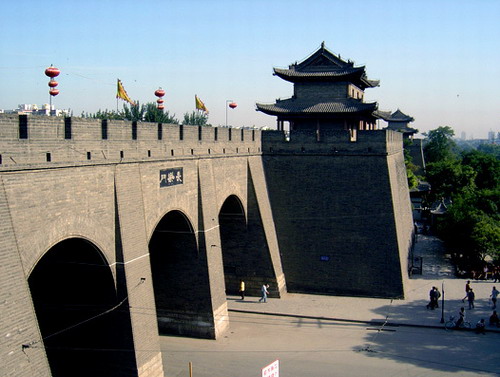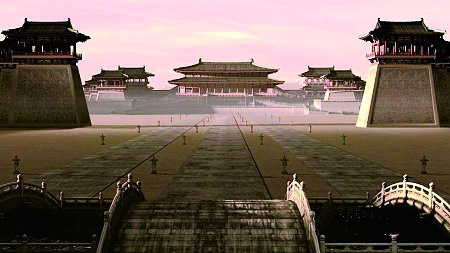西安
Xi'an (Western Peace) is the capital of Shaanxi Province 陕西 in northwest China, located in the Guanzhong Plain 关中 . It is one of the oldest cities in China. Before the Ming Dynasty, it was called 长安 , the Perpetual Peace. It is one of the four great ancient capitals of China. It is the starting point of the Silk Road and is best known for the Terracotta Army of the First Emperor.

Practical Information:
- Population: 8,467,837 inhabitants (2010)
- Area: 9,983 km2
- Density: 848 inhabitants/km² - Postal Code: 710000 - 710090
- Area Code: 029
- Coordinates: 34° 15′ N 108° 57′ E
- City Flower: Pomegranate
- City Tree: Japanese Pagoda Tree
- Website: www.xa.gov.cn
History of Xi'an
Xi'an has a rich history and significant cultural heritage.
Origin
Xi'an became a cultural and political center of China in the 11th century BCE with the founding of the Zhou Dynasty 周 . The Zhou capital was established in the twin settlements of Fengjing 丰京 and Haojing 鎬京 , together known as Fenghao 沣镐 , located southwest of contemporary Xi'an. This arrangement was also known as Zongzhou 宗周 to indicate its role as the capital of the vassal states. In 770 BCE, the capital was moved to Luoyang 洛阳 due to political unrest. After the Warring States period, China was unified under the Qin Dynasty 秦 (221-206 BCE) for the first time, with the capital located at Xianyang 咸阳 , just northwest of modern Xi'an. The first emperor of China, Qin Shi Huang 秦始皇 , ordered the construction of the Terracotta Army and his mausoleum just east of Xi'an almost immediately after his ascension to the throne.

In 202 BCE, Emperor Liu Bang 刘邦 , the founder of the Han Dynasty, established his capital at Chang'an. His first palace, the Changle Palace 长乐宫 (the palace of perpetual happiness), was built across the river from the ruins of the Qin capital. This is traditionally considered the founding date of Chang'an, or Xi'an. Two years later, Liu Bang built the Weiyang Palace 未央宮 (the palace that has not yet reached its midpoint) north of modern Xi'an. The Weiyang Palace was the largest ever built on Earth, covering 4.8 km², which is 6.7 times the size of the current Forbidden City, or 11 times the size of Vatican City.
Ups and Downs
In 190 CE, amidst uprisings and rebellions just before the Three Kingdoms period, a powerful warlord named Dong Zhuo 董卓 moved the court from Luoyang to Chang'an to avoid a coalition of other powerful warlords against him.
After several centuries of turmoil, the Sui Dynasty 隋 reunified China again in 582. The Sui emperor ordered the construction of a new capital southeast of the Han capital, called Daxing 大兴 (great prosperity). It consisted of three sections: the imperial city, the palace, and the civilian section, with a total area of 84 km² within the walls. At the time, it was the largest city in the world. The city was renamed Chang'an by the Tang Dynasty 唐 .
Xi'an was devastated at the end of the Tang Dynasty in 904. The inhabitants were forced to move to the new capital at Luoyang. Only a small part of the city continued to be occupied afterward. During the Ming Dynasty, a new wall was built in 1370 and remains intact to this day. The wall measures 11.9 km in circumference, 12 m in height, and 15 to 18 m in thickness at the base. A moat was also built outside the walls. The new wall and moat would protect a much smaller city of 12 km².
In October 1911, during the revolution in which the Qing Dynasty was overthrown, the Manchus living in the northeastern intra-muros area of the city were massacred. In 1936, the Xi'an Incident took place inside the city during the Chinese Civil War: Chiang Kai-shek was kidnapped and held hostage by the warlord Zhang Xueliang, negotiating with the communists. Zhang Xueliang 张学良 wanted Chiang to agree to form a united front with them to fight against the Japanese. The incident brought the Kuomintang (KMT) and the Communist Party of China to a truce to focus on fighting the Japanese invasion. On May 20, 1949, the Communist-controlled People's Liberation Army took the city of Xi'an from the Kuomintang.
Geography and Climate
Xi'an is located on the Guanzhong Plain in the central-southern part of Shaanxi Province, on a floodplain created by the eight surrounding rivers and streams. The city has an average elevation of 400 meters above sea level, and the annual precipitation is 553 mm. The urban area of Xi'an is located at 34° 16'N 108° 56'E. The Wei River 渭河 provides drinking water to the city.
The city borders the northern foot of the Qin Mountains 秦岭 to the south and the banks of the Wei River to the north.
The climate is humid subtropical, characterized by hot, humid summers and cool winters. Average temperatures range from about -4°C in the coldest month to +32°C in the hottest month, with an annual average of +13.2°C; the annual rainfall is 573 mm.
The Terracotta Army
The Mausoleum of Emperor Qin Shi Huang 秦始皇 is undoubtedly the most iconic site in Xi'an. Discovered in 1974 by local farmers, this archaeological site houses the Terracotta Army, a collection of more than 8,000 life-sized terracotta soldiers, horses, and chariots buried with the first emperor of China to protect him in the afterlife. Each statue is unique, with faces and expressions reflecting the individual traits of the soldiers of the time.
The Wall of Xi'an
Another must-see is the Xi'an Wall, dating back to the Ming Dynasty 明 and remains one of the best-preserved in China. With a length of nearly 14 kilometers, it is an excellent place for a bike ride or walk, offering panoramic views of the modern and ancient city.
The Muslim Quarter
The Muslim Quarter of Xi'an is home to the Hui community 回 , Chinese Muslims who have settled in the region for centuries. This vibrant neighborhood, with its narrow streets and bustling markets, is an excellent stop to taste local street food and explore the Great Mosque of Xi'an, a fascinating blend of Islamic and Chinese architecture.
Gastronomy
Xi'an cuisine is renowned for its robust flavors and varied textures. Local specialties include roujiamo, often called the "Chinese hamburger," and biangbiang noodles 麺 , wide and thick, served with a spicy and aromatic sauce. Be sure to try the lamb or beef pao mo, a flavorful soup garnished with pieces of soaked flatbread.
Museums and Culture
For those looking to deepen their understanding of Chinese history, the Shaanxi Museum offers an extensive collection of artifacts spanning millennia, from the earliest dynasties to the modern era. Additionally, the Xi'an Art Museum and various contemporary art galleries provide insight into the city's emerging art scene.
